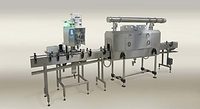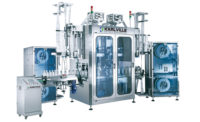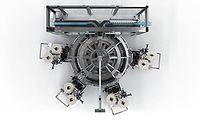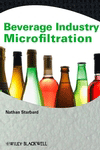The United States market was introduced to 1,709 new beverages from January to July 2011, according to Chicago-based Mintel International’s Global New Products Database. With so many new products in the beverage sector, companies continue to search for ways to help their products stand out on store shelves. These store-shelf marketing initiatives are not only impacting the beverages, but also the labeling equipment for the products, equipment manufacturers say.
“Brand managers are looking big time at the product as point-of-purchase advertisement,” says Raul Matos, executive vice president of sales and marketing for Karlville Development Group North and South America, Miami.
Matos says using shrink sleeve labels on containers can allow beverage-makers to convey their message on the entire bottle compared to other forms of labeling, and if beverage companies are looking to cut costs, he suggests looking into other aspects besides labeling.
“Cut cost somewhere else, don’t cut cost in front of your consumer,” he says. “You’ve got to give them the best-looking, attractive product so you can drive sales.”
Karlville recently released a shrink sleeve prototyping system called the Steambox. The Steambox was designed to help converters simulate the shrinkage process of full-size steam tunnels in-house without having to buy an expensive steam tunnel, the company says. The compact design and affordability of the Steambox makes it the ideal tool for shrink label testing, it says. The Steambox’s patented design is easy to transport and quick to set up, it adds.
Dave Niemuth, director of labeling technology for Krones Inc., Franklin, Wis., also sees a valuable role for shrink sleeve applications in marketing platforms, particularly with containers that are contoured or of a different shape than straight beverage containers. Niemuth adds that shrink sleeves have the capability to shrink up to 60 to 70 percent, which also allows companies to use shrink sleeves with tamper-evident labeling.
“We vertically and horizontally [perforate] near the top of the label so that after it passes through the steam tunnel and eventually makes its way onto the store shelf, the consumer easily breaks the vertical perforation to open the label; then the top of the label comes off horizontally allowing easy access to the contents of the container,” he says. “The rest of the label remains on the container; but because the label initially goes up over the top of the cap, you utilize it both as a tamper-evident [seal] and as a body label. So it’s a unique application in that it’s two for the price of one.”
PDC International Corp., Norwalk, Conn., also manufactures labeling equipment that applies heat-shrinkable tamper-evident seals and full-body sleeve labels.
“The sleeving material flows over a mandrel, which can be cylindrical, oval or rectangular,” says Gary Tantimonico, vice president of PDC International. “The mandrel opens and forms a sleeve.”
Tantimonico adds that PDC International’s mandrels are coated with a special extra-hard, low-friction surface for extended life.
Labeling equipment manufacturers understand how important the marketing side is for their customers and their processes, but they also know that beverage manufacturers are looking at more than marketing efforts.
“On the marketing side, beverage companies are constantly coming up with new ideas involving container shapes requiring orientation of the labels, containers requiring tamper-evident bands and in many cases both,” says Ed Farley, Axon sales director. “From the production side, beverage companies have many more requirements from special material handling needs, such as labeling empty containers and container/label orientation, to efficiency requirements, such as [overall equipment effectiveness] tracking to total line controls integration.”
Sustainable demands
Although some beverage-makers are using shrink sleeves, contoured containers and more to market their products and brands, some companies are looking to minimize the size of their labels.
Krones’ Niemuth says using labeling applications such as roll-on-shrink-on (ROSO) can offer a cost-savings application that requires less shrink.
“It gives marketing the flexibility to better utilize the shaped container, which adds to shelf appeal to the product,” he says. “... [Water] bottles are being light-weighted, so they’re taking gram weight out of the bottle itself; they’re making the cap smaller in height; they’re making labels smaller. This is a big cost saving because there’s not a whole lot of profit built into a case of water ... so they’re trying to take out as much cost as possible from the package.”
In addition to cost savings, machinery manufacturers understand companies want practices to be sustainable. The Swiss-based Sidel Group sees sustainability as a popular trend, including increasing total recyclability.
“Our latest sleeving systems feature sleeve manufacturing on the line without any solvent or glue — better enabling recycled materials,” says Raffaele Pace, labeling product manager for Sidel Group. “Also for a pressure-sensitive label, we can utilize a thinned liner, reducing waste.”
Last year, Sidel released its new Rollsleeve rotary labeler machine that creates and applies plastic shrink sleeves from a machine direction orientation label roll onto glass, plastic and metal containers. The Rollsleeve technology does not stress the film because the label is tubed and wrapped around the container without any machine movement because only the bottle moves, the company says.
Sidel has tested the Rollsleeve on all principle materials that are available on the market, such as PET, recycled PET, PVC, PE, PP, OPS and PLA, the company says. It can apply labels that are 50 percent thinner compared to traditional sleevers with thickness ranging from 18 to 50 microns, the company says.
Karlville’s Matos says glue can have an effect on the recyclability of containers.
“People are realizing even though that bottle is PET, it’s really one item; the label is something else,” he says. “So when the bottle maker makes that bottle, yes it’s PET, but when you put the label on, it’s PET and paper, so it’s not recyclable unless you take the label off, or unless you have a manufacturing process that takes the label off with lasers or something like that. That’s a very big trend that people are starting to figure out, these issues that affect the recycling process.”
Sustainability also continues to affect the weight of materials used and how labeling equipment manufacturers are approaching those materials.
“From a sustainability standpoint, customers are asking us to process thinner gauge materials as well as the new ‘green’ materials such as PLA,” Axon’s Farley says. “Both of the above mentioned items have required some minor changes to our machinery that are now standard features.”
Companies also are accommodating businesses with different labels addressing the importance of fast changeover and the different levels of operations. Last year, B & H Labeling Systems, Ceres, Calif., introduced the next generation of Marathon roll-fed labelers.
B & H offers three models of Marathon labelers, all designed for ease of use, low maintenance and high operating efficiencies with fast size changeovers and exceptional reliability, the company says. Suited for low- to mid-speed operations, the Marathon SLA labels up to 450 containers a minute, the company says. The Marathon XLA achieves speeds up to 650 containers a minute, according to the company. The high speed Marathon XLUA features a 180-degree U-shaped conveyor that maximizes container stability at speeds up to 650 containers a minute, it says.
Trending topics
Even though sustainability and marketing are important for beverage-makers, companies still are looking at increasing efficiency and higher speed applications.
“Beverage manufacturers want smarter, faster, safer machinery requiring less operator involvement,” Axon’s Farley says. “They also want 24/7 service support to ensure optimal uptime.”
Peter Lister, global product manager for Domino Amjet Inc., Gurnee, Ill., says the demand is growing for increased use of shelf-ready packaging for easier stacking in retail locations.
“From a labeling perspective, the position of the label and the information that is required makes labeling equipment with all its flexibility an ideal match,” he says.
Lister adds that the industry is seeing an increasing need to integrate reject stations, vision systems and human elements for inspection to detect impurities, defectiveness and overall safety.
“Labeling technologies as a part of this inspection process make for an ideal solution to accommodate the needs of the manufacturer, retailer and consumer,” he says.
But machinery manufacturers also see secondary packaging having an effect on labeling.
“The most significant beverage industry trend that we have seen impact labeling equipment is the movement toward shrink wrap for case packaging, particularly for soft drinks and bottled water,” says Drew Weightman, vertical marketing manager for beverages for Videojet Technologies Inc., Wood Dale, Ill. “The trend has increased the use of labels for affixing information, particularly at the case level.”
Weightman cites that producers who want a variable data barcode on each shrink wrapped case turn to the label to provide contrast for the barcode.
Cost also will continue to be an area of concern for labeling equipment manufacturers to address.
“A new machine that we just recently designed is a stretch sleever,” Krones’ Niemuth says. “The stretch sleeve is LDPE, which is low-density polyethylene and about 30 percent less than the cost of a traditional shrink sleeve. In addition to the 30 percent cost saving versus a shrink sleeve, the other major factor is that you eliminate the need for a shrink tunnel, which results in additional savings for utilities and space requirements. Once the sleeve is put on the mandrel we stretch that sleeve open, the container is presented to the sleeve, and the sleeve conforms to the container once it’s released off its mandrel.”
Machinery manufacturers also understand the importance of cohesion among the equipment. For its Aurora line, Axon offers its PackML programming language.
“By standardizing on PackML, the system offers simplified line integration and consistent terminology for easier operation, troubleshooting and maintenance,” Farley says.
Karlville’s Matos says having compact lines with high efficiency can make it easier for companies that are looking to incorporate shrink sleeve equipment.
“We’re able to provide the whole package, not only from the application, but also our converters that make our labels locally are able to provide a complete purchase package for our customers,” he says. “Brand owners have been able to enjoy higher sales and transform their image in the market.” BI






